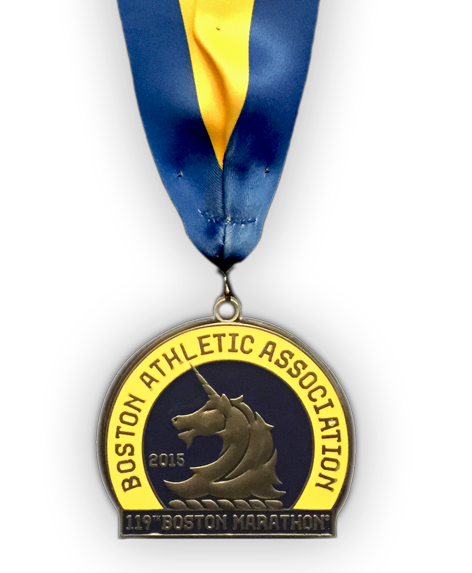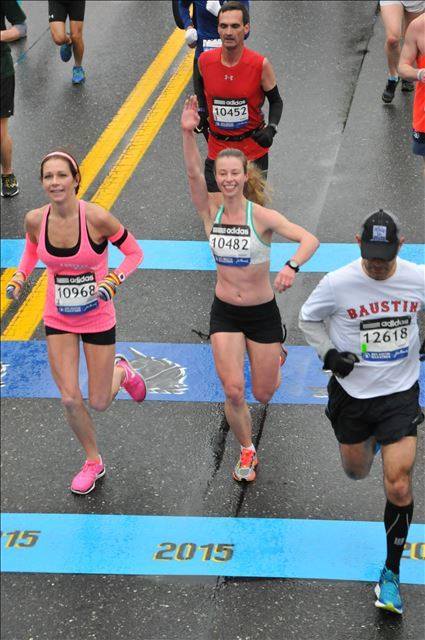Many runners dream of one day crossing the finish line of the Boston Marathon. I know this because I was one of those runners. When I was fifteen, I saw the Boston Marathon on TV. Ever since then, I dreamed of running it. Then, finally, in April 2015, ten years after I first saw the race on TV, I lived my dream.
To say that crossing the finish line was a life-changing experience is an understatement. Despite being about 50 minutes too slow to qualify for the Olympics in the Marathon (Canadian Standard is sub 2:30), completing the Boston Marathon made me feel like an Olympian. There were so many people watching the race and cheering for all of us. Although we were nowhere near the elites, we all still got a lot of accolades and high fives. I loved the atmosphere. It was a fantastic experience overall.
It also took a lot for me to get there. When I toed the start line of my first marathon, I didn’t really think I would qualify because many people told me that “barely anyone ever qualifies for the Boston Marathon on their first attempt” and that I was “too slow to even think about it”.
Then, continued to train and I actually qualified for the Boston Marathon when I ran my first marathon. If you have been chasing a BQ for the past few years, please don’t despair. Even if you don’t qualify on your first attempt, I highly encourage you to keep trying. You may need to revise your training and nutrition at some point. Whatever you do throughout your marathon running journey, you must never give up on your goals.
Below are tips to help you qualify for The Boston Marathon:
- Review the qualifying standards carefully. Once you’ve reviewed the qualifying standards, understand that to guarantee your spot in the race you must run at least 5 minutes faster than the qualifying standard for your age and gender. There are so many people applying to run the race. Therefore, running a 3:34 when your standard is 3:35 will not get you in. It is so heartbreaking to see a runner beat the qualifying time by one or two minutes only to have their Boston Marathon application rejected because there were people who applied that had greater differences between their qualifying standard and the time they ran.
- Figure out what pace per mile (or KM) you need to run to be able to achieve that goal time. For example, if you need to run a sub 5 min km for all 42.2km, it’s very good to know that. You also have to make sure that your goal pace is realistic. It’s important to do some longer sustained efforts at your desired race pace.
- Pick a fast course to attempt to qualify. An ideal course would be relatively flat with minimum sharp turns. It would preferably be done as close to sea level as possible and in temperatures that are not too hot and not too cold. I ran my personal best (3:18) at the Goodlife Fitness Victoria Marathon, which I think is a great course. I’ve also qualified for Boston at the BMO Vancouver Marathon twice. Another good example of a PB-friendly race is the California International Marathon. Also, keep in mind that more often than not, it’s best to attempt to qualify for the Boston Marathon in your own time zone and ideally as close to your home town as possible. Speaking from experience, I’ve never been able to get a personal best at any marathon that I’ve had to travel to.
- Give yourself enough time to train before your goal race. An ideal length of time to train consistently for a marathon is 6 months.
I trained for my first marathon for 6 months. The first two months helped me gradually increase my mileage to 70–85km per week without risking injury. After that, I was able to add hills and speed work to my training routine. I also did some training at my race pace or even faster. Then, I had a three-week taper. I felt super fresh on race day (at least at the beginning of the race).
You cannot rush your marathon training if you want to qualify for Boston. Rushing your marathon training can lead to injuries.
- Don’t skip your long run. The long run will help you improve your aerobic fitness and boost your confidence that you can actually go the distance. You should do at least 3 or 4 runs that are longer than 32km before your marathon. When I was training for my first marathon, I really emphasized the long run. Not only did I need to be physically prepared for running 42.2 km, but I also had to feel mentally prepared. The only way I knew how to mentally prepare myself for that distance was to actually do the distance (or close to). My longest run prior to my first marathon was 39km. It was exactly 4 weeks before my race day. After running 39km, I felt ready to tackle 42.2km. I don’t think I would have felt ready if I only ran 34km for my long run. The long run gave me the confidence I needed to make it to the start line. Some people may think that 39km is too long for a long run prior to doing a marathon but I needed to do it because I wanted to feel mentally ready.
- Hills are your best friends. Learn to love hill workouts. Hill training helps increase leg strength and power as a result of the resistance that hills give you. It will also help prepare you for the faster and more demanding workouts that are ahead of you.
- Train at goal race pace. You should strive to train at your goal race pace once a week, especially after you are done the base-building phase. Your race pace training run doesn’t have to be super long. However, it will give you the confidence that you can keep it up.
- Don’t be too stressed about qualifying for the Boston Marathon. There will be plenty of other chances if it doesn’t happen at your next marathon.
- Enjoy the journey. Listen to your body. Make your workouts fun. Cross-training will help you decrease your risk of injuries. You should also run with your friends and add a social aspect to your running journey.
If you found these tips helpful, please share with anyone who hopes to one day qualify for the Boston Marathon.
_________________________________________________________________________
If you are looking for gear and nutrition recommendations, click here
If you would like a running program, you can contact me here.

